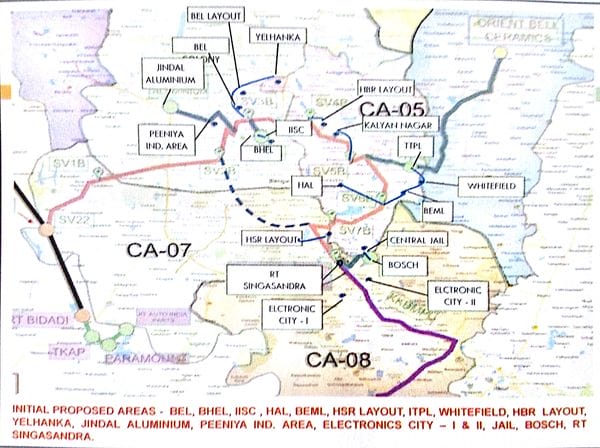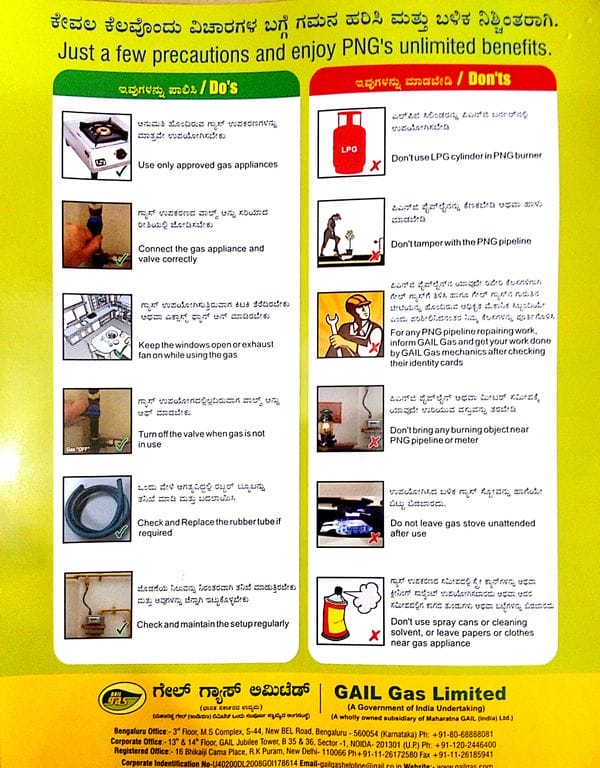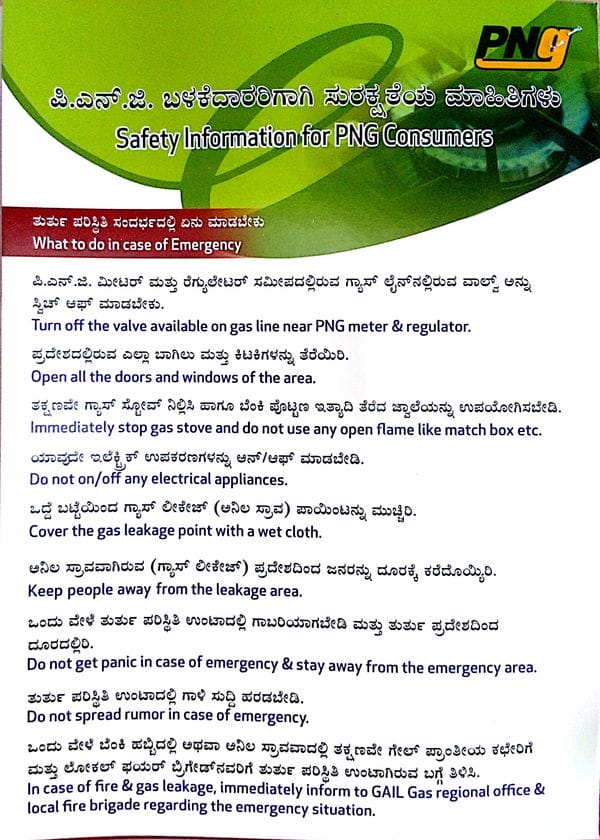Amidst the complaints raised by residents of HSR Layout, Gas Authority of India Ltd (GAIL) is busy laying pipelines across the city to provide piped natural gas to households in Bengaluru as a part of its City Gas Distribution (CGD) project. However, many people are unaware of what is going on – as we see roads dug up, trenches and warning signage in front of homes.

GAIL’s map for the City Gas Distribution Project in Bengaluru.
Here is all you should know about CGD.
What is City Gas Distribution Project?
Control Room for GAIL Gas Ltd
080 6888 8081
City Gas Distribution Project is a network for supplying Liquefied Natural Gas (LNG) to domestic, commercial, industrial and transport sectors. It intends to replace the expensive liquid petroleum gas with the comparatively cheaper natural gas. GAIL Gas Ltd, a subsidiary of GAIL (India) Ltd, a central public sector undertaking, has won the bid from Petroleum and Natural Gas Regulatory Board (PNGRB), to implement the city gas distribution project in Bengaluru.
City Gas Distribution Project has two objectives: First, to distribute Piped Natural Gas (PNG) to domestic, commercial and industrial users; Second, to supply Compressed Natural Gas (CNG) for vehicles. Through PNG, GAIL intends to replace LPG cylinders which are mostly used for domestic and commercial consumption. Cylinders will be replaced by natural gas through direct pipe connection to households. Houses will be fitted with smart meters and the consumer has to pay the bill based on quantity consumed.
CNG will be stored in the CNG stations that are to be setup in different locations, to be supplied to vehicles that ply using CNG. With the implementation of City Gas Distribution Project, Bengaluru will follow the footsteps of Delhi and Mumbai where the project has already been rolled out. There will be CNG-certified vehicles, including BMTC buses that will make use of CNG.
Why Natural Gas?
Natural gas is much cheaper, safer and greener when compared to LPG. It is safer than LPG because it is lighter than air, and therefore rises up when it leaks, lessening the possibility of ground level fire disasters. LPG is heavier than air, so settles down when leaked, and if there is a fire it is sure to affect the vicinity.
Natural gas is greener, because its main component is methane. The pollution caused while burning natural gas is considerably less, when compared to diesel. Pollution caused by industries, commercial establishments and vehicles which are highly dependent on diesel could be controlled by shifting to natural gas.
In fact, the Supreme Court ruling for New Delhi and NCR on December 16th 2015, had directed the government to ensure that the taxi fleet in New Delhi and NCR should run entirely on CNG. It was one of the measures suggested by the SC to check the rising pollution levels in Delhi.
How much cheaper will natural gas be?
Considering the current market price (as on January 1st 2016), the cost of piped natural gas for domestic use is Rs 22 per Standard Cubic Meter (SCM), Rs 33.4 per SCM for industrial use, Rs 41 per SCM for commercial use (for customers who consume up to 500 SCM per day) and Rs 33.4 per SCM for commercial use (for customers who consume more than 500 SCMD). The cost of CNG is Rs 44 per kg. Though there is not much price variation when compared to diesel and petrol, CNG is still recommended for automobiles as it is burns cleanly, and there is little chance of the vehicle accidentally catching fire.
On the domestic consumption front, GAIL Gas Ltd claims that CNG works out to be cheaper than LPG. If the price of one LPG cylinder (subsidised) is Rs 430, the cost of PNG for 15 SCMD as proposed by GAIL is Rs 330. 15 SCMD is equivalent to one cylinder. Therefore, those who are now getting subsidised LPG cylinders can enjoy the benefit of Rs 100 per month, whereas the non-subsidised LPG holders can reap more benefit.
However, the actual price when it reaches the consumers depends on various factors such as basic gas price in the market, transportation cost, capital cost of pipeline laying and the government taxes.
Status of the project in Bengaluru
Areas to be covered in 5 years:
Year 1: ITPL & OBCL, Peenya bus depot, Kamalanagar, Hennur, BEL, BHEL, HSR Layout, Jindal, IISC.
Year 2: HSR Layout, Outer Ring Road, HAL, Silk Board to Shanti Nagar, Malleswaram, ITPL.
Year 3: Kasturi Nagar, HAL, BEML, Yeshwantpur, Sanjay Nagar, RMV Extension, Koramangala, Electronic City.
Year 4: Jayanagar, JP Nagar, Sahakar Nagar, Yelahanka, Indira Nagar, Domlur, Sadashiva Nagar.
Year 5: Sarjapur Road, Banashankari, Marathahalli.
So where does the natural gas pipeline come from and where does it go to?
Bengaluru will draw natural gas from the 1,000 km long Dabhol-Bengaluru pipeline. This pipeline was ready in 2013. The high-pressure main pipeline ends at Bidadi and GAIL has established a gas tapping station at Sulivara, a few kilometres before Bidadi, from where a pipeline has been laid connecting the city via Outer Ring Road. This 18-inch pipeline passes through Hebbal, HRBR, Hennur, Mahadevapura, Domlur, HSR Layout, Agara lake and ends at Singasandra on Hosur road.
From the pipeline that passes through ORR, connectivity is given to Bengaluru city through various smaller 5-inch branch pipes. The work on laying pipe through ORR was completed a year ago and now GAIL is connecting households through branch pipes.
“GAIL secured the contract to supply natural gas to Bengaluru Urban and Rural districts. The areas that come under the project include Nelamangala, Doddaballapur, Devanahalli, Hoskote, Bangalore East, North, South and Anekal, covering 4,395 sq km,” said an official from GAIL Gas Ltd, who did not wish to be named.
GAIL got the authorisation from PNGRB to implement the project on February 18th 2015. According to the contract terms, GAIL is supposed to give 1,32,000 direct domestic connections within five years of project implementation. GAIL intends to connect at least 2,50,000 houses. “It is an egg or chicken first situation. We are laying the pipeline with the hope that people will opt for Piped Natural Gas,” he says.
“We have already laid pipeline for about 90 km in the city. It includes 60 km in HSR Layout and 20 km in BEL Colony. We need to lay around 800 to 900 km in five years. Our target is to lay pipeline stretching across 800 to 900 km. After the completion of work in HSR Layout, we will move to Mangammanapalya and Singasandra,” the officer told Citizen Matters.
Supply to begin this month end
Apart from laying the pipeline, GAIL has also started giving pipe connection to apartments and individual houses which have placed the demand for PNG. Connection with smart meter has been given to around 1,100 houses in BEL quarters in Jalahalli, and 100 houses in HSR. These connections have been given after obtaining permission from RWAs, claims the GAIL official.
However, GAIL is yet to commence the gas supply. “We are doing the testing now. Gas will be supplied after all the precautionary measures are in place. Probably, we will begin the supply by this month end,” the officer informed us.
It is not mandatory for people to shift to natural gas. But people who wish to switch from LPG to PNG, should first surrender cylinders to their service provider.
The next step is to submit an application to a GAIL distributor, by paying an application fee of Rs 100 and registration fee of Rs 300. GAIL has already signed up distribution agents in some parts of the city. A refundable security deposit of Rs 5,000 has to be paid to the agent. Once, all this is done, GAIL will lay the pipeline to your house. The online application service is yet to start.
Commercial and industrial connections
With commercial and industrial connections being more profitable than residential connections, as the demand volume is high, GAIL is eyeing those areas. It has already started supplying PNG to Bosch and BHEL, while Intel and Biocon have lined up for the connection. GAIL has not given any commercial connections inside Bengaluru yet. However, talks are on with a food chain giant to provide PNG, the GAIL officer said.
CNG is yet another area that the GAIL will cover. Four CNG stations in Bengaluru are expected to operate by March 2016, and 12 more stations may come up in next few months. GAIL has also been demanding that BMTC introduce CNG buses in the city.
In November 2015, the government had given the go-ahead for BMTC to add 200 CNG buses to its fleet. However, in a recent interview with Citizen Matters, to a query on introducing CNG buses, BMTC MD Ekroop Caur had said that they may use CNG on a pilot basis, but was not very sure about it.
Safety concerns on GAIL pipelines
With the gas pipeline covering a large part of the city, how safe are we? What steps have been taken to avoid the disaster that may occur in case of leakage? “Piped Natural Gas is absolutely safe and is not hazardous in nature,” claims the GAIL official.
While the 18-inch pipe that passes through ORR is made of steel, the 5-inch pipe that passes through residential areas is made of Medium Density Polyethylene. The pressure of gas which is 19 bar on the steel pipe that passes through ORR, is reduced to 4 bar when it passes through MDP pipe. This will be further regulated and reduced to 21 millibar when it enters the kitchen and it is safe enough. All the pipes except the one that enters the kitchen will be underground and safely guarded with mats and bricks, he said.
The officer added that the safety aspect was taken care of during the design stage itself. There will be round the clock surveillance, GIS-based control systems and emergency response vehicles.
“We have organised awareness programmes in schools and neighbourhoods and distributed pamphlets about the dos and don’ts in case of gas leak in BEL quarters. The same will be done in other areas too before supplying the gas.

Dos and dont’s for PNG customers.
In case of leakage, people should call the 24×7 control room,” said the GAIL official. He added that the gas supply hadn’t started yet, as some of the precautionary measures are yet to be in place.

Safety information distributed to PNG customers
Related Articles
HSR sector 7: caught between GAIL and BBMP
GAIL pipeline-laying work in HSR Layout: Is there a violation?
Awesome info about CNG/PNG being shared for a novice person like us. This info has to shared to lot of people!! I have used PNG in Mumbai and the Gas Supply is all thru the 365 days and has a post paid billing cycle.
Useful info. Thanks. Whom do I contact to get info on when my area will get covered?
Thanks for this info as I have been looking for it. I am interested in knowing whether GAIL would provide PNG to apartments at M.S.Nagar area of Thirumenahalli, next to Hegde Nagar on Thanisandra Main Road. If so when? Pl help.
What about safety aspect in case of the following:
– Earthquakes. Depending on the scale of the quake, the pipes may crack (either the underground pipes, or the overground last-mile-connectivity pipes leading into our homes). That would mean a leak.
– Random digging by our honorable, esteemed agencies like BBMP, BDA, BESCOM, BWSSB, etc. The JCB digger is their weapon by birthright. Given that we dont have detailed maps of underground utilities (nor do our esteemed agencies honor them), how safe are the underground GAIL pipes?
We don’t have piped water going everywhere and these people are dreaming up piped gas.Let”s move on to the next pie in the sky idea please. What’s up with HSR layout and such cloudy ideas? Last week it was a turf covered cycle path and now this piped gas business. We have a large population still burning all kinds of combustible things in various slums across the city and sending up particulates into the sky – could GAIL or another company find a way of providing a better cooking fuel to these people, rather than mess with HSR layout. This monkeying with piped gas should also give another agency (GAIL) the opportunity to dig up roads and join the grand list of road digging aspirants along with BWSSB, BESCOM, BBMP, BDA and assorted private cable layers.
Mr. Suresh, the list of areas to be covered under PNG project is given in the article. You can check whether your area comes under the locations mentioned in the box.
Good to see this.
But isn’t it surprising that we are able to get piped gas before piped water? #mafia #nexus
Hi,
Still its dream for Bangalore to get CNG for automobiles.. every time they commit some month and again it will be postpone without the reason. March 2016 commited that atleat 4 CNG stations will open but still no news…
Natural Gas is a user friendly, economic, safer and non-polluting fuel. It is theoretically 10% cheaper than domestic LPG. It does not require booking of refill, chasing up delivery, hassles of facing delivery boys, storage space etc. There are no chances of pilferage. PNG is safer as compared to LPG due to its light weight nature. In the event of leakage, it dissipates immediately in the air. The supply of PNG can be easily controlled by various safety checks/valves installed in the system.
What happens , if gas is leaked .